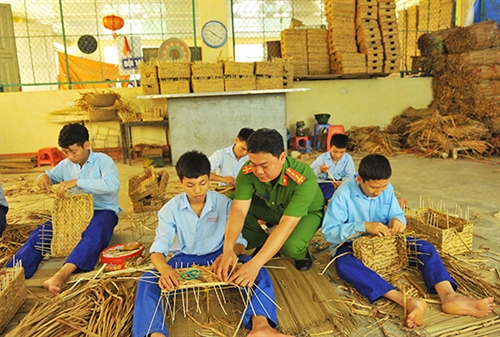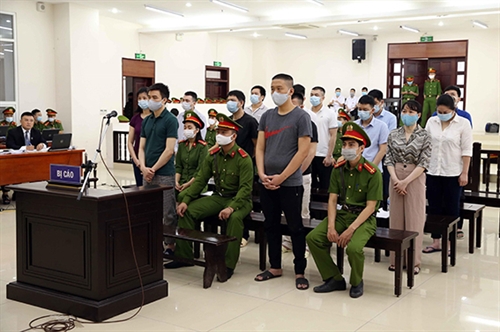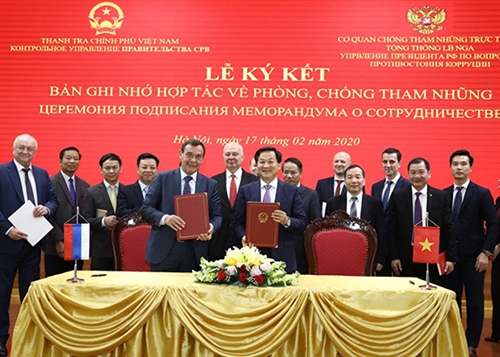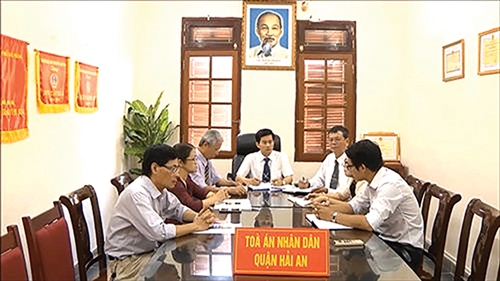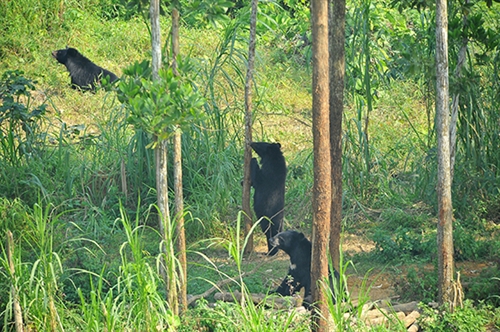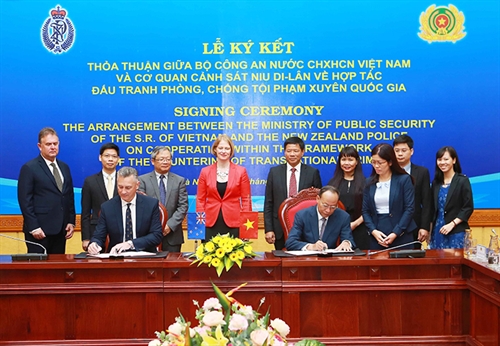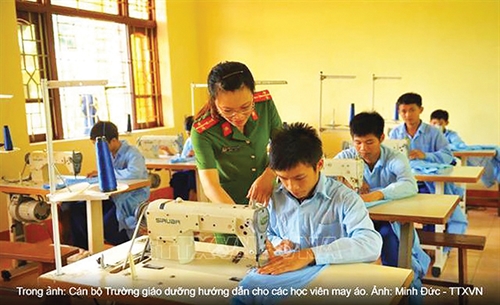The draft Law Revising a Number of Articles of the Intellectual Property Law has been put for public opinions and is expected to be submitted to the 15th National Assembly for consideration and comments at the 2nd session, and passage at the 3rd session. The amendments and supplementations focus on seven main groups of policies recently approved by the National Assembly, including improvement of the effectiveness of the intellectual property (IP) rights protection. This article introduces some models of specialized IP court in a number of countries in the world and makes some recommendations for Vietnam to improve the effectiveness of its IP rights protection activities.
Ta Dinh Tuyen, LL.M.
Deputy Editor-in-Chief
People’s Court Magazine of the Supreme People’s Court
Models of specialized intellectual property court in several countries in the world
Japan
Japan has eight high courts located in Tokyo, Osaka, Nagoya, Hiroshima, Fukuoka, Sendai, Sapporo and Takamatsu, and six branches of these courts. The Intellectual Property High Court of Japan (IPHCJ)[1] was established on April 1, 2005, as a special branch of the Tokyo High Court in order to accelerate and reduce the costs of patent litigation. The IPHCJ hears appeals from district courts on patent actions and suits against appeal/trial decisions made by the Japan Patent Office (JPO). The IPHCJ is also the exclusive court of appeals that settles matters related to the rights of computer program authors, utility model rights, and integrated circuit layout design protection.
Japan has a highly specialized IP dispute resolution system, in which the Board of Appeals of the JPO settles complaints about invalidation/termination of validity of protection titles; and the IP divisions of district courts (such as Tokyo or Osaka) settle cases related to IP rights infringement. If one of the disputing parties disagrees with the JPO’s decision or the judgment/decision of the district court, he/it can appeal to the IPHCJ.
Procedure at district courts
IP rights infringements, depending on geographical regions, may be heard according to first-instance procedure at the district court of Tokyo or Osaka. Either of these courts has an IP division with technicians who can assist judges in technical matters involving complicated subjects such as patent infringements.
| Year | Commenced | Disposed | Average duration from commencement to disposition (months) |
| 2011 | 90 | 91 | 7.5 |
| 2012 | 101 | 108 | 7.7 |
| 2013 | 114 | 99 | 6.7 |
| 2014 | 138 | 111 | 7.1 |
| 2015 | 137 | 162 | 7.8 |
| 2016 | 118 | 129 | 8.3 |
| 2017 | 105 | 115 | 7.3 |
| 2018 | 92 | 85 | 7.7 |
| 2019 | 85 | 88 | 7.0 |
| 2020 | 69 | 65 | 9.0 |
Table 1: Number of intellectual property appeal cases commenced and disposed, and average duration from commencement to disposition[2]
According the Patent Act of Japan, only the JPO has jurisdiction to invalidate a patent. However, a court may refuse to enforce an IP right if there are grounds to believe that a patent may be terminated/invalidated.
To settle an accepted case, the court holds a number of hearings on the dispute based on documents previously submitted by parties. If at the hearings, the parties reach an agreement, the court will record it and terminate the settlement of the case. If not, the court will proceed to settle the case and assess damage based on submitted documents. In 2006, the average time to hear an IP infringement case at court was 12.5 months.
Procedure at the IPHCJ
If one of the parties disagrees with the JPO’s decision or the judgment/ruling of the district court, he/it can appeal to the IPHCJ. The procedure at the IPHCJ is the same as that at district courts. The IPHCJ hears the parties presenting their views on the dispute with the aid of technical means to explain technologies involved in the case. Judges of the IPHCJ are briefed by technical advisors on relevant technical issues to ensure a basic understanding. According to statistics, the average time to hear a case at the IPHCJ during the period from 2011 to 2020 was between 6.7 months and 9 months.
| Year | Commenced | Disposed | Average duration from commencement to disposition (months) |
| 2011 | 453 | 407 | 7.5 |
| 2012 | 457 | 463 | 8.1 |
| 2013 | 353 | 429 | 7.6 |
| 2014 | 278 | 311 | 8.2 |
| 2015 | 263 | 269 | 8.7 |
| 2016 | 279 | 264 | 8.0 |
| 2017 | 237 | 263 | 9.1 |
| 2018 | 183 | 218 | 9.3 |
| 2019 | 174 | 166 | 8.6 |
| 2020 | 152 | 159 | 9.6 |
Table 2: Number of suits against appeal/trial decision made by the JPO commenced and disposed, and average duration from the commencement to the disposition[3]
In considering appeal of both IP rights infringements and invalidation of protection titles, the IPHCJ allows parties to submit additional evidence to substantiate the matters under consideration. However, the parties may not bring up new matters other than those already considered by the JPO or district courts. The parties may submit expert opinions, experimental results, references and other evidence, provided that such documents are solely to support arguments made earlier, without giving rise to new arguments. For example, if the JPO invalidates a patent for the reason that it does not meet requirements for invention, the parties can only present new evidence to prove that the invalidated patent meets creativity requirements. The IPHCJ does not allow parties to present evidence regarding the novelty of the patent. If a party finds out a ground for invalidating a protection title, i.e. the novelty, such party should initiate a request for invalidation on this basis at the JPO.
Appeal to the Supreme Court
The IPHCJ’s rulings can be further appealed to the Supreme Court of Japan, but such cases are rare. The Supreme Court rarely overturns the IPHCJ’s rulings because the Supreme Court only reviews the legal issues of the rulings, not the cases.[4]
Thailand
Thai IP laws and regulations have been regularly amended in recent years to comply with international standards, as follows:
- The Patent Act B.E. 2522 (1979) was amended in 1999 to comply with the Trade-Related Aspects of Intellectual Property Agreement (TRIPS) and to facilitate participation in regional and international patent agreements;
- The Copyright Act B.E. 2537 (1994) was amended in 2018;
- The Trademark Act B.E. 2534 (1991) was amended in 2016;
- The Plant Variety Protection Act B.E. 2542 (1999);
- The Trade Secrets Act B.E. 2545 (2002) was amended in 2015;
- The Protection of Geographical Indications Act B.E. 2546 (2003).
Generally, Thailand’s IP laws comply with international intellectual property standards including those established the World Trade Organization’s TRIPS and the Berne Convention for the Protection of Literary and Artistic Works (the Berned Convention). Thailand is also a State Party to other key IP conventions aimed at creating an equal, standardized IP protection system throughout the world. In 2008 and 2009 respectively, Thailand concluded the Paris Convention for the Protection of Industrial Property and the Patent Cooperation Treaty. Thailand is also a signatory to the Berne Convention, and the Madrid Protocol.
IP issues are also mentioned in bilateral and multilateral cooperation agreements Thailand has signed. For example, the Japan-Thailand Economic Partnership Agreement devotes one chapter consisting of 23 articles to IP that mainly deals with simplifying and increasing transparency of procedures, strengthen IP rights protection and enforcement.[5]
Regarding enhancing capacity for IP dispute resolution, in 1997 Thailand established the Central Intellectual Property and International Trade Court (CIPITC)[6] that has exclusive jurisdiction to adjudicate civil and criminal cases involving IP. The experience of the judges has been improving over the years as training courses have been organized for court officials, judges, customs officers, and personnel of other IP enforcement agencies (notably the Department of Special Investigation and the Royal Thai Police). The establishment of an IP database to monitor the status of infringement cases, court rulings and repeated offenses is also expected in the near future. This would improve the overall level of IP enforcement in Thailand. In 2016, the Sub-Committee for the “Suppression of Intellectual Property Infringement” was founded to solve and prevent IP infringement issues, reduce problems for IP rights holders, increase IP rights protection in accordance with international standards, and build Thailand’s image as an IP-friendly country.
In terms of jurisdiction, according to the Act for the Establishment and Procedure for Intellectual Property and International Trade Courts B.E. 2539 (1996), the jurisdiction of the Central Intellectual Property and International Trade Court covers six provinces, namely Bangkok, Samut Prakan, Samut Sakhon, Nakhon Pathom, Nonthaburi, and Pathum Thani.
However, as regional Intellectual Property and International Trade Courts have not yet been established, the jurisdiction of the Central Intellectual Property and International Trade Court, therefore, covers the entire Kingdom, according to Section 47 of the Act for the Establishment of and Procedure for Intellectual Property and International Trade Court B.E. 2539 (1996) which is a transitory provision. In order to facilitate convenient and uncostly proceeding, the plaintiff in a civil case may submit the plaint to the provincial court within the territorial jurisdiction of which the defendant is domiciled or to the provincial court within the territorial jurisdiction of which the cause of action arose. The plaintiff in a criminal case may submit the charge to the provincial court within the territorial jurisdiction of which (i) the offense has, or is alleged or believed to have been committed, or (ii) the defendant is residing or has been arrested, or (iii) the inquiry has been held.[7]
Table 3: The 2020 annual judicial statistics of the Central Intellectual Property and International Trade Court[8]
As for appeal to the Supreme Court, the Act for the Establishment of and Procedure for Intellectual Property and International Trade Court (Second Issue) B.E. 2558 (Section 40 paragraph 1) stipulates that “an appeal against any judgment or order of the Court of Appeal for Specialized Cases shall be submitted to the Supreme Court and the provisions of the Civil Procedure Code and/or the Criminal Procedure Code shall apply mutatis mutandis”.
Other countries
In China, to further strengthen judicial protection of IP rights and unify adjudication criteria for IP cases, with the approval of the Standing Committee of the National People’s Congress, IP courts were established in Beijing, Shanghai and Guangzhou in 2014. In 2020, the fourth IP court was established in Hainan island (operating from January 1, 2021). The Supreme People’s Court has issued relevant judicial interpretations, defined the jurisdiction of the IP courts, and provided guidance on the appointment of IP judges and participation of IT officers in judicial activities.
IP divisions have also been established in the Supreme People’s Court, high courts and intermediate people’s courts.
In Korea, the Patent Court of Korea was established under Article 3(1) of the Court Organization Act on March 1, 1998. The Patent Court has territorial jurisdiction over the entire nation. Therefore, a suit seeking a review of a ruling or decision made by the Intellectual Property Trial and Appeal Board (IPTAB) should be filed to the Patent Court regardless of the party’s domicile. Any appeal of the Patent Court’s rulings should be brought directly to the Supreme Court, as the Patent Court is an appellate-level court. The Patent Court exercises exclusive jurisdiction over certain matters as specified by the Patent Act, the Utility Model Act, the Design Act and the Trademark Act, and other relevant laws including the Act on the Protection of New Varieties of Plants. Since January 1, 2016, the Patent Court has also had exclusive appellate jurisdiction over civil actions relating to IP rights.
The Patent Court is composed of one chief judge, five presiding judges, 11 judges, 17 technical advisors, and one secretariat now. Five divisions, each consisting of three three-judge panels, hear the cases. Highly technical matters are referred to technical examiners who have long-term experiences in such fields as mechanical engineering, electronic engineering, chemical engineering.
The Patent Court is an appellate-level court. However, there is no hierarchical relation whatsoever between the revocation proceedings of the Patent Court and the proceedings of the IPTAB, and the records from the proceedings of the IPTAB are not transferred to the Patent Court. Accordingly, the same contentions and evidences as those already submitted to the IPTAB must be submitted again to the Patent Court for a new determination at the Patent Court. Any appeal of the Patent Court’s rulings should be brought directly to the Supreme Court.[9]
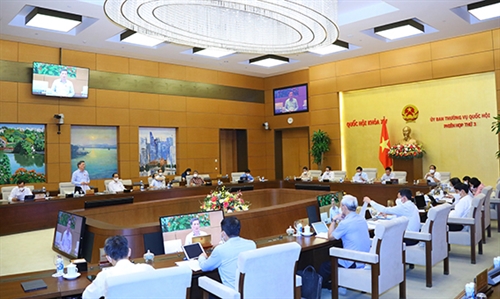 |
| A meeting to discuss the draft Law Revising a Number of Articles of the Intellectual Property Law on Sep. 14__Photo: Nguyen Diep/VNA |
Recommendations for Vietnam
The IP court is one of specialized courts established by many countries to resolve IP disputes. In Vietnam, from the current context and reality, it is necessary to study the possibility and roadmap to establish such court for the following reasons:
Firstly, the trend of international integration of IP has become common and inevitable in the context of globalization. Vietnam has signed bilateral agreements related to copyright such as Agreement on the Establishment of Copyright Relations between Vietnam and the US (1997); Bilateral Intellectual Property Agreement between Vietnam and Switzerland (1999); and the US-Vietnam Bilateral Trade Agreement (2000). In 2004, Vietnam applied for accession to become a State Party to the Berne Convention and the Rome Convention for the Protection of Performers, Producers of Phonograms and Broadcasting Organizations (1961). As committed in the Bilateral Agreements with the US and Switzerland and WTO requirements, Vietnam has acceded to the Geneva Convention and Brussels Convention and complied with the provisions of the TRIPS. Vietnam’s laws have also recognized civil jurisdiction of the People’s Courts to resolve disputes over copyright, copyright-related rights, industrial property rights, and technology transfer between individuals and organizations. The settlement of this type of dispute is based on principles, order and procedures generally prescribed in the Civil Procedure Code[10]. In 2005, Vietnam enacted the Intellectual Property Law and now the country is in the process of revising many contents of this Law to suit practical requirements.
Secondly, IP rights dispute resolution mechanism is cumbersome, expensive and inefficient[11]. The 2005 Intellectual Property Law, revised in 2009, does not have separate provisions on the mechanism for IP rights dispute resolution. Article 198 of this Law provides that, when there is a ground to believe that the protected IP is being infringed upon by a certain legal or natural person, the IP rights holder may initiate a lawsuit at a court to protect its/his/her legitimate rights and interests. This is a civil remedy. When initiating a civil lawsuit, the IP rights holder has the right to request a competent court to apply the following civil remedies in handling the person(s) that has/have committed acts of infringing upon IP rights: (i) compelling the termination of infringing acts; (ii) compelling public apology and rectification; (iii) compelling performance of civil obligations; (iv) compelling payment of damages; and (v) compelling destruction, distribution or use for non-commercial purposes of goods, raw materials, materials and means used largely for the production or trading of IP rights-infringing goods, provided that such destruction, distribution or use does not affect the exercise of rights by IP rights holders (Article 202). In addition, when initiating a lawsuit or during court’s acceptance of a dispute for resolution, an IP rights holder has the right to request the court to apply provisional urgent measures in some cases.
According to Article 30.2 and Article 37.1 of the 2015 Civil Procedure Code, disputes over IP rights or technology transfers among legal or natural persons, which are all for the profit-making purposes, fall under jurisdiction of provincial-level courts. As per the 2014 Law on Organization of People’s Courts, provincial-level courts may have criminal, civil, administrative, economic, labor, and family and juvenile tribunals. In case of necessity, the National Assembly Standing Committee shall decide to establish other specialized tribunals at the proposal of the Chief Justice of the Supreme People’s Court (Article 38). Specifically, the civil tribunal has jurisdiction to settle civil, business and/or trade, bankruptcy, labor, and administrative cases if this court does not have administrative, economic, and labor tribunals. The economic tribunal has jurisdiction to settle business and/or trade, and bankruptcy cases, as designated under Circular 01/2016/TT-CA of the Chief Justice of the Supreme People’s Court. Therefore, IP rights disputes other than business and/or trade cases fall under the jurisdiction of the civil tribunal, while IP rights disputes that are business and/or trade cases fall under the jurisdiction of the economic tribunal. Disputes over copyright and copyright-related rights will be resolved by courts according to civil procedure or arbitration (Article 49.3 of Decree 22/2018/ND-CP).
However, the application of civil procedure provisions in the resolution of IP rights disputes has revealed some limitations, especially in case of resolving disputes related to specific subject matters such as invention, identification of acts of unfair competition in protected IP. The civil lawsuit mechanism remains cumbersome, costly and ineffective. Therefore, it is necessary to have a separate legal mechanism to resolve such IP rights-related disputes, thereby protecting the legitimate rights and interests of IP rights holders.
Thirdly, IP rights-related disputes are increasing in number and complexity, especially in the context that Vietnam is revising the Intellectual Property Law in the direction of increasing the jurisdiction for courts to resolve such disputes. However, at present, Vietnam has no specialized IP court and no judges in exclusive charge of this field. Furthermore, professional IP training is insufficient and ineffective. Therefore, Vietnam needs to establish a specialized IP court with well-trained judges knowledgeable about this field to make accurate judgments and solve the root cause of IP infringements.[12]
Civil remedies through courts have advantages to better protect IP rights holders. Specifically, courts’ rulings are enforceable and have a higher deterrent effect on subjects infringing upon the IP rights. In addition, civil remedies are supported by a mechanism for application of provisional urgent measures to quickly protect evidences, maintain the status quo, and avoid causing aggravation to IP rights holders.
According to Article 211.1.a of the current Intellectual Property Law, any person that commits an act of “infringing upon IP rights causing damage to consumers or society” will be subject to administrative sanctions. This provision is too general in nature, leading to the understanding that all objects of IP rights are able to be protected through administrative remedies. This is the basic cause/legal basis leading the fact that IP rights holders and state management agencies prefer choosing administrative remedies to handle IP rights infringements.
Under the draft revised Intellectual Property Law, Article 211.1.a may be amended as follows: “infringing upon intellectual property rights, including copyright, copyright-related rights, marks, geographical indications, and plant varieties, causing damage to authors, rights holders, consumers, or society” (option 1).[13]
With this amendment, it can be understood that infringements against other IP rights objects namely inventions, industrial designs, semiconductor integrated circuits, trade names, and trade secrets will not be subject to administrative remedies. Therefore, in principle, if there is a dispute over these IP rights objects, only courts have jurisdiction to resolve such dispute.
If this proposal is approved, this will be a significant step forward in the process of transfer of the dispute-resolving jurisdiction to courts, enhancing the position and role of courts in the protection of IP rights. However, this will also cause big challenges to the court system, because the IP subject matters, particularly inventions and semiconductor integrated circuits, are those with high technical contents, requiring court officers to master not only the IP law, but also issues related to science and technology.[14]
Hence, several experts proposed the establishment of IP tribunals at provincial-level courts and high courts. In terms of jurisdiction, provincial-level courts have jurisdiction to adjudicate all kinds of IP dispute cases. IP tribunals of high courts have the role of appellate trial of first-instance judgments and rulings of provincial-level courts which have not yet taken legal effect and are appealed or protested against. Furthermore, the current civil procedure related to IP dispute resolution should also be reviewed and revised in the direction of shortening and simplifying adjudication mechanism, applying provisional urgent measures, etc. to better and promptly ensure the legitimate rights and interests of IP rights holders.[15]
Against the backdrop of international integration and increasingly diverse and abundant IP assets, Vietnam needs to continue improving legal institutions and framework to protect IP rights more effectively, especially those to facilitate resolution of IP rights-related disputes by a specialized court. This is an objective requirement in the process of judicial reforms in general and improvement of the legal mechanism to protect IP rights in particular, in Vietnam nowadays[16].-
[1] See website of the court at: https://www.ip.courts.go.jp/eng/index.html.[2] Source: https://www.ip.courts.go.jp/eng/vc-files/eng/2021/e_kousosin.pdf.[3] Source: https://www.ip.courts.go.jp/eng/vc-files/eng/2021/e_siketutorikesi.pdf.[4] Settling IP disputes in Japan and some recommendations for Vietnam, Portal of the Ministry of Science and Technology’s Inspectorate, at: https://thanhtra.most.gov.vn/thanhtra/tin-tuc/4/204/giai-quyet-tranh-chap-quyen-so-huu-tri-tue-tai-nhat-ban-va-mot-so-goi-mo-doi-voi-viet-nam.aspx.[5] Experiences of Thailand in IP and renovation protection, Portal of the National Center for Socio-Economic Information and Forecast, Ministry of Planning and Investment, at: http://ncif.gov.vn/Pages/NewsDetail.aspx?newid=22056.[6] See website of the Court at: https://ipitc.coj.go.th/th/content/page/index/id/191441.[7] See Jurisdiction of the Central Intellectual Property and International Trade Court at: https://ipitc.coj.go.th/th/content/page/index/id/191448.[8] 8 Source: https://ipitc.coj.go.th/th/file/get/[9] See International Department of the Supreme People’s Court of Vietnam, International experiences on the court system of several countries in the world and recommendations for Vietnam’s court apparatus, People’s Court Journal, vol. 15/2021, p. 55. See more at: https://patent.scourt.go.kr/patent_e/intro/intro_01/index.html.[10] See Nguyen Van Luat, The demand of establishing IP court in Vietnam, Legislative Studies vol. 15 (391), August 2019, online version at: http://lapphap.vn/Pages/tintuc/tinchitiet.aspx?tintucid=210379.[11] Ibid.[12] Ibid.[13] See the draft at: https://duthaoonline.quochoi.vn/Pages/dsduthao/chitietduthao.aspx?id=7371.[14] See Tran Manh Hung, Nguyen Tuan Linh, It is necessary to establish IP court, Investment online at: https://baodautu.vn/can-thanh-lap-toa-an-chuyen-trach-ve-so-huu-tri-tue-d144711.html.[15] Ibid.[16] See Supra note 10.
